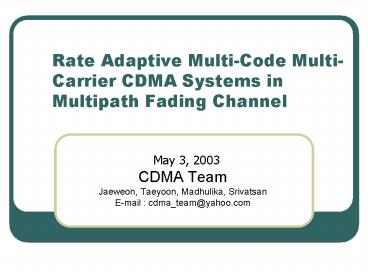Rate Adaptive MultiCode MultiCarrier CDMA Systems in Multipath Fading Channel - PowerPoint PPT Presentation
1 / 32
Title:
Rate Adaptive MultiCode MultiCarrier CDMA Systems in Multipath Fading Channel
Description:
E-mail : cdma_team_at_yahoo.com. May 3, 2003. CDMA Team. Contents ... [1] T.S. Rappaport, Wireless communications, Principles and Practice, 2nd Ed., Prentice Hall ... – PowerPoint PPT presentation
Number of Views:183
Avg rating:3.0/5.0
Title: Rate Adaptive MultiCode MultiCarrier CDMA Systems in Multipath Fading Channel
1
Rate Adaptive Multi-Code Multi-Carrier CDMA
Systems in Multipath Fading Channel
May 3, 2003
- CDMA Team
- Jaeweon, Taeyoon, Madhulika, Srivatsan
- E-mail cdma_team_at_yahoo.com
2
Contents
- Introduction Motivation
- System Description
- Channel Model
- Adaptation Algorithm
- Simulation Set up Results
- Conclusion Future Work
3
Introduction
- Future wireless systems
- integration of voice, data, image, video.
- Variety of data rates
- Concerns
- unfriendly wireless channel
- multipath propagation
- doppler shift
- multiple access interference
4
Possible Solutions
- Spread Spectrum techniques
- combat fading effects
- Multi-Carrier
- Robustness against multipath and interference
rejection - Multi-Code systems
- variable data rate
5
Multi Code System
- High data rate stream split into number of
parallel low-rate streams - Low-rate streams are spread by different
sequences and added before transmission - High and variable data rates
6
Multi-Code Sytem(2)
- Multi-Code CDMA with Variable Sequence-Sets,
H.D.Schotten, H.Elders-Boll, A. Busboom - Each user has a sequence set of some size M .
7
Multi-Code System
M-ary data symbols
10
Channel
G1(n) G2(n) G3(n) . . . GM(n)
1111 1010 1100 1001
Cos(wct)
. . .
8
Multi-Code System (MTC)
- Performance in AWGN
- Adaptive Algorithm
- Parameters - Min data rate, max BER, max
transmit power - Users increase the size of the sequence set to
achieve the data rate, and the transmit power to
decrease the BER.
9
Motivation Objectives
- Evaluate the performance of Multi-Code System in
fading channel - Different codes for the sequence sets - Walsh,
Gold, Kasami - Increase capacity
- By using multi-carriers
- Choices - MC-CDMA, MC-DS-CDMA
- Better Adaptive algorithm
- Parameters - channel condition, desired BER, data
rate
10
Multi-carrier System (I)
- Spread spectrum/CDMA with spreading in the
frequency domain - DS-CDMA followed by IFFT
- OFDM preceded by orthogonal matrix operation
- Frequency diversity with each bit transmitted
simultaneously on many sub carriers.
11
Multi-Carrier System
Data Stream
12
Why Multi-Carrier?
- Channel - multipath fading
- Destructive interference due to multipath causes
deep nulls in the channel frequency response. - In case of wideband signals dips in the spectrum
result in a small loss of signal power. - Spectral nulls are unlikely to occur at all of
the subcarrier frequencies.
13
System Description
14
Multi-code Multi-carrier System(MTC-MC System)
15
Multicode Multicarrier DS CDMA System (MTC-MC-DS
System)
- MC-CDMA outperforms MC-DS-CDMA in multipath
fading channels - Hence not evaluated
- Overview of Multicarrier CDMA, S.Hara,
R.Prasad
16
Abbreviations
- CDMA Code Division Multiple Access
- MTC CDMA Multi-Code CDMA
- MTC-MC CDMA Multi-Code Multi-
- Carrier CDMA
- MC-CDMA Multi-Carrier CDMA
17
Channel Model
- Multipath Rayleigh Fading Channel
- Principles of Mobile Communication by Gordon L.
Stuber
18
Rate Adaptation
- Parameters
- Instantaneous SINR of the channel
- Desired BER
- Maximum data rate
19
Rate Adaptation
20
Simulations
21
Simulation Setup
- L (Length of multicode sequence) 256
- M 2,4,8,16,32,64,128,256
- Speed of vehicle 60 m/s
- Carrier frequency 900 MHz
- Max. Doppler frequency 50 Hz
- No. of subcarriers 16
22
Simulations
- Present the performance of MTC CDMA in fading
channel using different codes. - Compare MTC CDMA to MTC-MC CDMA in Fading channel
- Compare MTC-MC CDMA with Adaptation to MTC CDMA.
- Compare the MTC-MC CDMA with Adaptation to MTC-MC
CDMA
23
Multi-Code System with different codes
24
MTC AWGN vs. MTC Fading
25
MTC Adaptation vs. MTC in Fading Channel
26
MTC, MTC-MC (w and w/o Adaptation) in Fading
Channel
M2.96
M18.7
M92.0
M161.3
M197.6
27
Adaptive Algorithm (MTC)
28
Conclusions
- The system capacity in the Multi-Code CDMA is
improved by use of Multi-Carrier scheme. - Adaptive algorithm based on instantaneous channel
condition improves the average data rate without
decreasing the performance
29
Future work
- Mathematical Analysis
- Simulations for the asynchronous case
30
References
- 1 T.S. Rappaport, Wireless communications,
Principles and Practice, 2nd Ed., Prentice Hall - 2 H.D.Schotten, H.Elders-Boll, A,Busboom,
Mutli-Code CDMA with variable sequence sets,
IEEE 6th International Conference on Universal
Personal Communications 1997, Vol. 2, pp. 12-16,
Oct. 1997 - 3 D.W.Hsiung, J.F.Chang, Performance of
multi-code CDMA in a multipath fading channel.,
IEE Proceedings-Communications, Vol.147 Issue 6,
Dec. 2000 - 4 S.Hara, R.Prasad, Overview of Multi-Carrier
CDMA, IEEE 4th International Symposium on Spread
Spectrum Techniques and Applications Proceedings
1996, Vol. 1, pp. 22-25, Sep. 1996 - 5 Gordon L. Stuber, Principles of MOBILE
COMMUNICATION, Klwer Academic Publishers - 6 A.J. Goldsmith, S.G. Chua, Variable-Rate
Variable-Power MQAM for Fading Channels, IEEE
Transactions on Communications, Vol.45, No.10,
Oct. 1997
31
QA
32
- Thank you































